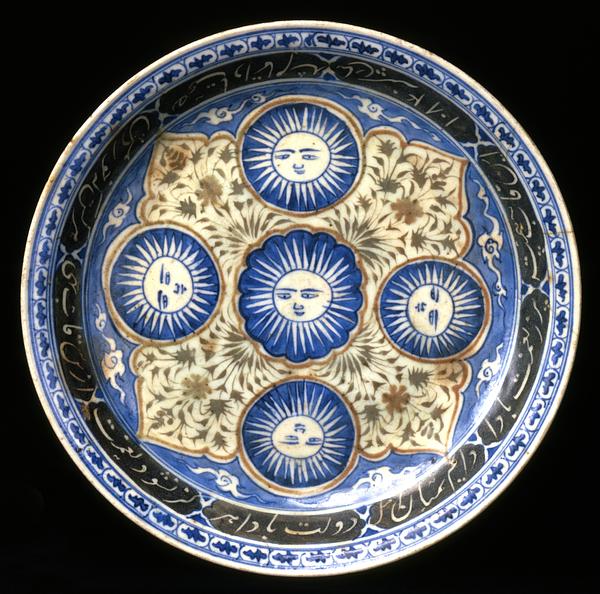Fritware dish, painted in blue and black and with a red and a green slip under a transparent glaze
Iran, Kerman; dated 1084 H = 1673
H: 6; Diam: 36 cm
Pottery decorated in blue and red (and green) from the Safavid period is frequently attributed to Kerman, where the distinctive type of pesudo-Chinese marks were also painted that are found under the base of this dish. The potters used Chinese porcelain as their models, but the plant decoration and the five suns with faces on the dish are un-Chinese.
The dish moreover carries a very common Persian inscription: “May this [large] dish always be full of [God’s] favors. May it always be found among fortunate people. May this [large] dish never be empty of [God’s] favors. May all who eat from it be healthy. It was finished in the year 1084 [= 1673].”
Inv. no. 4/1986
Published in:
Gaston Migeon: Exposition des arts musulmans au Musée des arts décoratifs, Paris 1903, pl. 49a;
Yolande Crowe: “A preliminary enquiry into underglaze decoration of Safavid wares” in Colloquies on Art & Archaeology in Asia, 8, 1979, pl. 5a;
Kjeld von Folsach: Islamic art. The David Collection, Copenhagen 1990, cat. 177;
Kjeld von Folsach: Art from the World of Islam in The David Collection, Copenhagen 2001, cat. 252;
Lisa Golombek: “The Safavid ceramic industry at Kirman” in Iran, 41, 2003, mentioned on pp. 263 and 270 note 45;
Lisa Golombek (ed.): Persian pottery in the first global age: the sixteenth and seventeenth centuries, Leiden 2014, fig. 2.82, p. 106;
Joachim Meyer, Rasmus Bech Olsen and Peter Wandel: Beyond words: calligraphy from the World of Islam, The David Collection, Copenhagen 2024, cat. 65, p. 209;
